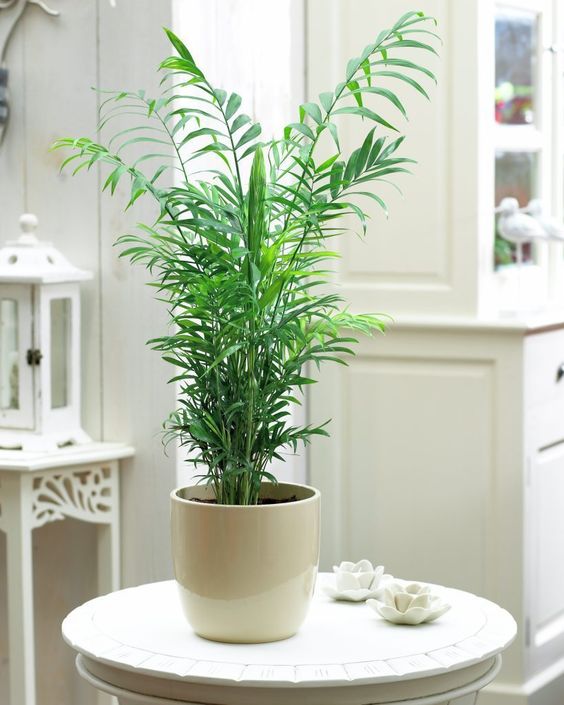Indoor plants are not only decorative. They can also have a positive effect on the indoor climate. You can take advantage of these features in the bedroom.
Bad indoor air in the bedroom can lead to worse sleep habits. Therefore, you should ventilate the room well before going to bed so that fresh air is sufficient throughout the night. You can also count on the right indoor plants as they can improve air quality. On the other hand, there are also some plants that emit CO2 themselves, so it is better to avoid them in the bedroom.
Do the plants in the bedroom get the oxygen?
There has been a myth for years that indoor plants in the bedroom can steal your oxygen. Background: Plants do not photosynthesize at night because they need sunlight for this, so they do not produce oxygen either. Rather, they take in oxygen at night. As a result, it can be thought that people may miss this oxygen. However, this concern is unfounded as the oxygen absorbed by plants is extremely low. If so, you need to have loads of plants in your bedroom before you “run out of air.”
But the myth also goes the other way around – namely that plants produce oxygen at night. This is not entirely true, but there are plants that emit oxygen at night. These include, for example, plants with thick leaves.
Why are plants useful in the bedroom?
There are many good reasons to place plants in the bedroom. Not only are they decorative and contribute to a more relaxed atmosphere, which can help you sleep better, but they also have other benefits. On the one hand, plants can clean the air and have a positive effect on the indoor climate. Some even specifically filter pollutants from the air, such as spider plants, rubber trees or ivy.
On the other hand, plants help balance the humidity in the room. Some plants, especially those with large leaves, have the ability to release moisture into the air. This includes, for example, the sword fern. Dry room air is a problem, especially in the winter months when the heating is on during the day. Plants can be used to prevent this. However, plants do not replace regular airing – even in winter.
9 plants suitable for the bedroom
Some plants are almost predestined for the bedroom for their air-healing properties. Read the overview of what’s included:

- Money Tree
Money tree (Crassula ovata) belongs to the succulent family. Like all plants in this family, the money tree is ideal for the bedroom. Succulent plants originally from hot desert regions are designed to lose as little water as possible during the day. They hide this in their thick leaves – hence the name. The oxygen produced by plants during photosynthesis cannot escape. But at night the money tree absorbs CO2 from the room air and releases the oxygen stored during the day.

- Aloe vera
Aloe vera is one of the most popular indoor plants in general – for good reason: it’s easy to care for, decorative and also has healing powers. The gel from the fleshy leaves can be applied directly to dry skin. In addition, the plant can reduce humidity and release oxygen, which is an advantage in the bedroom.

- Hemp bow
Sansevieria is a suitable plant for the bedroom for a variety of reasons. For one, it doesn’t need a lot of light to grow, which is a plus in the bedroom. It is one of the plants that can remove airborne pollutants like the spider plant. It is said to be good even for headaches. And finally, it is also highly decorative. However, a lot of dust can build up on large leaves over time, so you should wipe them off occasionally.

- ivy
Common ivy (Hedera helix) is a very good bedroom plant because it does not need a lot of light and also has an air-purifying effect. Accordingly, it must filter up to 94 percent of all pollutants in the room air, including mold spores. In addition, ivy does not require much maintenance. You can also put it in the bathroom as it does not mind high humidity. Direct sunlight should be avoided with ivy. Important: Ivy is poisonous – skin contact can cause inflammation.

5. Sword fern
Ferns are generally known to perform well in darker locations. This also applies to the sword fern (Nephrolepis). It is also said to have an air-purifying effect, so it is well suited as a bedroom plant. You should not be very economical when watering, sword fern likes it quite moist. Therefore, it is suitable not only for the bedroom, but also for the bathroom.

6. Spider plant
Spider plant (Chlorophytum comosum) is both decorative and easy to care for – and it’s ideal for the bedroom. It can also filter airborne pollutants such as toxic formaldehyde, according to a study by NASA. Houseplant provides restful sleep.

7.Mountain palm (Chamaedorea elegans) originally comes from Mexico and is one of the most popular indoor plants. It is also suitable for beginners, as it quickly forgives mistakes in care. It adds a tropical feel to the bedroom and also improves indoor air as it can absorb pollutants. However, direct sunlight should be avoided with the mountain palm.
What plants should you avoid in the bedroom?
Not all indoor plants are suitable for the bedroom. For example, strong-smelling herbs can reduce sleep quality and possibly even cause headaches. These include, for example, jasmine or lavender. Especially those with allergies should be careful. But diseased plants should also not be placed in the bedroom – allergic reactions may occur. This includes those with mold in the potting soil.














